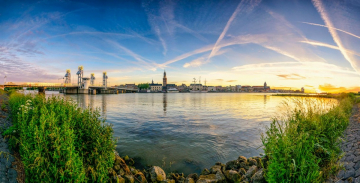Julie Mouton, Water Stewardship Service Leader at Antea Group, recently published an article in Water Resources IMPACT magazine.
Part of the American Water Resources Association (AWRA), IMPACT magazine is a practical, solution-oriented digital magazine containing diverse and timely articles written for water resources management professionals at all levels of their careers. The article below was published in the November/December 2021 issue, Water Risk in a Rapidly Changing World: Part 1.
Read the full issue on the AWRA website here.
STUDIES FROM THE INTERGOVERNMENTAL PANEL ON Climate Change (IPCC) and the National Aeronautics and Space Administration (NASA), among others in the scientific community, have emphasized that climate change is intensifying the water cycle. Warming temperatures are causing evapotranspiration rates to increase, accelerating the drying of land and vegetation. Weather patterns are affected, with more intense rainfall and associated flooding, as well as more intense drought, occurring in many regions. If these trends continue, the World Resources Institute predicts that by 2030 the world will face a 56% supply gap in viable freshwater resources, propelling almost half of the world's population into a state of severe water stress. This trajectory will undoubtedly generate more climate and water refugees, fleeing from places where their livelihoods are no longer viable.
It is clear that we cannot solve the water issue without solving the climate issue. Recognizing this, many industry leaders have set aggressive climate pollution reduction and water-related goals. In the beverage industry, many of the world’s top brands have come together to collaborate on these pre-competitive issues through the Beverage Industry Environmental Roundtable (BIER). Water is a main ingredient and a critical component in their agriculture-based supply chain, so it makes good business sense for these leaders to take action on water and climate. We have seen other large corporations step up recently—Microsoft, Facebook, and Google, for example, have all made pledges to replenish more water than they use in their direct operations by 2030. These actions by individual companies should be applauded and will hopefully propel more corporations to set aggressive targets. If we are going to change the trajectory we are on, we need to move beyond the leaders and approach water-related challenges using a risk-based tactic with actions at the watershed scale. The higher the risk, the more urgent the actions; the bigger a company’s water footprint, the bigger the actions.
For companies just starting out on getting a handle on water, we recommend pursuing a path with the following steps:
1. Do your research
Companies should determine whether they are operating in, or if their main suppliers are located in, a high-water-risk watershed. This step is critical for enterprise risk management. Many publicly available tools can help companies consider their exposure to chronic risks (such as degraded watersheds that lead to poor water quality and rising treatment costs) as well as to acute risks (such as flooding from storm surges and extreme weather events). These tools include the World Resources Institute’s (WRI) Aqueduct Water Risk Atlas and the World Wildlife Fund for Nature (WWF) Water Risk Filter. Given that water issues are extremely local, we recommend that companies evaluate the local context within the high-risk watersheds (including groundwater) where they operate to determine which vulnerabilities the facility and the watershed are most exposed to. Too much water, poor water quality, or not enough water can disrupt operations, supply chains, and the communities that depend on those water supplies, so it is important to keep tabs on current and projected conditions at regional or local levels to stay ahead of water-related business risks.
2. Develop site-specific water action plans
Using the information gathered, each high-risk location should develop a comprehensive water action plan. This plan should set goals that align with the local context. For example, we recommend that facilities with high levels of water stress optimize their water use (this should include evaluating opportunities for reuse and recycling, which would help limit once-through pass systems). Given that they are located in areas where the competition for water is high, they should determine the long-term sustainability of their water supplies. A water action plan could include the following:
- Tracking daily water usage and monthly water-quality data (incoming and outgoing);
- Ensuring water is used efficiently for production, processing, sanitation, and employee needs
- Maintaining equipment to ensure efficient water use
- Minimizing water used for landscape irrigation by planting native species and using rainwater collection systems
- Educating employees on water awareness
- Tracking local water supply conditions to maintain awareness of potential issues
- Ensuring that potential pollution sources on and off-site are addressed
- Preparing a plan for emergencies (such as natural disasters and water reductions or losses)
- Continuously evaluating opportunities for reduction, reuse, and wastewater recycling
- Analyzing water use and water risk in the supply chain
- Engaging with community stakeholders, including water service providers, municipalities, and local and national non-governmental organizations working to advance water security
- Testing the feasibility of collective action with other water users in the community
3. Engage and collaborate with stakeholders
As each site develops and implements its water action plan, it is equally important to engage with stakeholders to support the common goal of improving the water security of the region. Collective action is a key component of water stewardship, as framed by organizations such as the Alliance for Water Stewardship and the CEO Water Mandate, and is key to getting large-scale solutions implemented. These initiatives can be led by industry stakeholders, such as BIER’s first-of-its-kind watershed collaboration (known as “Charco Bendito,” in Jalisco, Mexico) or by a broader group of stakeholders, such as the Texas Water Action Collaborative, which formed to improve the Trinity River Basin.
The time to evaluate water-related business risks and establish and act on local, comprehensive water action plans is now. Such actions are an opportunity to foster business and community resilience. They are also a means to demonstrate leadership and boost reputation while contributing to the greater good—to change our current trajectory.
Contact us today to learn more about Water Stewardship and how you can make your business more sustainable and resilient to water challenges.
About The American Water Resources Association
Founded in 1964, the American Water Resources Association is a non-profit professional association dedicated to the advancement of men and women in water resources management, research, and education. AWRA’s membership is multidisciplinary; its diversity is its hallmark. It is the professional home of a wide variety of water resources experts including engineers, educators, foresters, biologists, ecologists, geographers, managers, regulators, hydrologists and attorneys.
Learn More About AWRAWant more news and insights like this?
Sign up for our monthly e-newsletter, The New Leaf. Our goal is to keep you updated, educated, and even a bit entertained as it relates to all things EHS and sustainability.
Get e-NewsletterHave any questions?
Contact us to discuss your environment, health, safety, and sustainability needs today.








